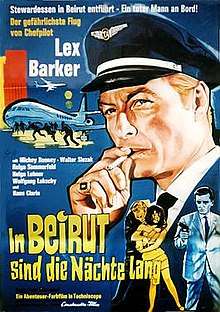24 Hours to Kill
24 Hours to Kill (aka Twenty-Four Hours to Kill and In Beirut sind die Nächte lang) is a 1965 British/German international co-production drama film shot in Techniscope and Technicolor that was filmed in the Lebanon, then a tax haven.[1] It was produced by Harry Alan Towers, directed by Peter Bezencenet, and stars Lex Barker, Mickey Rooney and Walter Slezak.
| 24 Hours to Kill | |
|---|---|
 German film poster | |
| Directed by | Peter Bezencenet |
| Produced by | Harry Alan Towers |
| Written by | Peter Yeldham Harry Alan Towers (story) |
| Starring | Lex Barker Mickey Rooney Walter Slezak |
| Music by | Wilfred Josephs |
| Cinematography | Ernest Steward |
| Edited by | John Trumper |
Production company | Grixflag Films Ltd. Towers of London (uncredited) |
| Distributed by | Seven Arts Pictures Constantin Film |
Release date | September 1965 |
Running time | 94 min. 88 min (re-edited for TV) |
| Country | United Kingdom West Germany |
| Language | English |
Plot
A Transcontinental Airlines airliner on an international flight develops engine trouble en route to Athens. Pilot Jamie Faulkner (Lex Barker) is forced to land in Beirut, where the aircraft is to layover for 24 hours. Although the crew look forward to rest and relaxation in the then glamourous tourist hot spot, one of the crew members is in fear of his life due to his being a target of a criminal organisation based in the city.
Purser Norman Jones (Mickey Rooney ), on the run from a gang of gold smugglers headed by Malouf (Walter Slezak), a smuggler, gains the sympathy of the flight's captain and other members of the crew who believe that Jones has been wrongly associated with the syndicate.
The gang twice attempts to kill Jones and tries to kidnap air hostess Louise Braganza (Helga Sommerfeld), the captain's girl friend. Jamie learns that Jones is a member of Malouf's gang and has actually stolen £40,000 worth of bullion from the syndicate.
Although the gangsters kidnap air hostess Françoise Bertram (France Anglade) to propose an exchange. Françoise, however, after a fight, is rescued by the airline crew. Jones is captured by Malouf but saved by Jamie and the crew, but just as the airliner takes off, Jones is killed by one of Malouf's men.
Cast
- Lex Barker as Captain Jamie Faulkner
- Mickey Rooney as Norman Jones
- Michael Medwin as Tommy Gaskell
- Wolfgang Lukschy as Kurt Hoffner
- Helga Sommerfeld as Louise Braganza
- France Anglade as Françoise Bertram
- Helga Lehner as Marianne
- Walter Slezak as Malouf
- Hans Clarin as Elias
- Shakib Khouri as Andronicus
- Issam Chenawi
- Giancarlo Bastianoni as Killer
- Maria Rohm as Claudine
Production
24 Hours to Kill was written by Peter Yeldham who travelled to Beirut to research the film's plot.[2] According to German reviewer, Oliver Nöding, casting Lex barker and Mickey Rooney and using an exotic setting was standard procedure for the low-budget Towers of London production team.[3] [N 1]
The aircraft in 24 Hours to Kill included:
- Antonov An-24B
- Convair 880-22M
- de Havilland DH-106 Comet 4C, c/n 6446, OD-ADQ
- Douglas DC-4
- Douglas DC-8-33
- Ilyushin Il-18
- Lockheed Constellation
- Sud-Aviation SA316B Alouette III, c/n 1118
- Sud-Aviation SE-210 Caravelle VI-N, c/n 174, OD-AEO [5]
Reception
Andy Webb, writing in The Movie Scene noted the beauty of Beirut before mideast strife destroyed the once glamorous capital. Webb considered 24 Hours to Kill "quite entertaining and has a touch of 60s spy movie about it with a few moments of action, drinks laced with drugs, shady people following Norman around and of course some danger."[6]
References
Notes
Citations
- Mann 2014, p. 45.
- Taylor 2015, pp. 28-29.
- Nöding, Oliver. "24 hours to kill (Peter Bezencenet, Great Britain 1965)." funkhundd.wordpress.com, 25 January 2014. Retrieved: 5 August 2019.
- Maltin 1994, p. 48.
- Santoir, Christian. "Review: '24 Hours to Kill'." Aeromovies 17 January 2015. Retrieved: 5 August 2019.
- Webb, Andy. "Review: '24 Hours to Kill': Rooney's nervy Norman." The Movie Scene, 2019. Retrieved: 5 August 2019.
Bibliography
- Maltin, Leonard. Leonard Maltin's Movie Encyclopedia. New York: Penquin Books, 1994. ISBN 978-0-45227-058-9.
- Mann, Dave. Harry Alan Towers: The Transnational Career of a Cinematic Contrarian. Jefferson, North Carolina: McFarland & Company, Inc., 2014. ISBN 978-0-78647-982-5.
- Taylor, Tadhg. "Peter Yeldham Interview" in Masters of the Shoot-'Em-Up: Conversations with Directors, Actors and Writers of Vintage Action Movies and Television Shows. Jefferson, North Carolina: McFarland & Company, Inc., 2015. ISBN 978-0-78649-406-4.